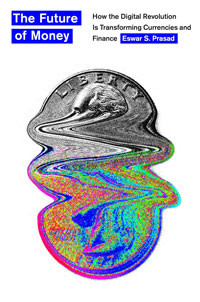The Future of Money: How the Digital Revolution Is Transforming Currencies and Finance

Eswar S. Prasad
Belknap Press,
Cambridge, MA, 2021, 496 pp., $35.00
Among the many technological changes in today’s digital economy, disruption is also occurring in one of the most fundamental technologies of our societies: money itself.
In his new book, The Future of Money: How the Digital Revolution Is Transforming Currencies and Finance, Eswar Prasad puts this disruption into broader context. He argues that for all the digital innovation in finance in the past decades, we are standing on the precipice of what may be an even more dramatic change, with broad social, economic, and political implications. He shows convincingly that amid fintech, cryptocurrencies, and stablecoins—and the potential demise of cash—one of the most far-reaching innovations would be central bank digital currencies (CBDCs), a new form of central bank money.
Loading component...
The book gives an impressive overview of the many changes digital technologies have already wrought. From the dramatic growth of mobile money in East Africa and China to the emergence of peer-to-peer lending and microinsurance, fintech has already shaken up finance and included hundreds of millions of new users in the financial system—particularly in emerging market and developing economies. He describes Bitcoin, Ethereum, and the distributed ledger technologies underlying them—but also the disappointment around their actual use in payments to date. CBDCs, Prasad argues, are an even bigger breakthrough. They could serve as a backstop to privately managed payment systems, further enhance financial inclusion, improve monetary policy transmission, and even fight corruption. But he is equally cognizant of the risks around the bypassing of banks, loss of privacy, and Orwellian oversight of citizens by authorities—risks that can be mitigated through proper design and legislative oversight.
The book gives a sweeping overview of developments in payments, from the specifics of Ant Group’s business to the e-krona project and Venezuela’s Petro. It is interspersed with great anecdotes, like ABBA singer Björn Ulvaeus’s battle against cash in Sweden (and the crime he says it fuels), to the acerbic dismissal of regulatory sandboxes (controlled testing environments for innovative services) by former New York Department of Financial Services Superintendent Maria Vullo (“Toddlers play in sandboxes. Adults play by the rules.”). As we would expect from an international macroeconomist like Prasad, there is also plenty of discussion on the implications of fintech and CBDCs for cross-border payments and the role of the US dollar as a reserve currency.
The Future of Money is an engaging read, and a contribution to a genre. It fits nicely into a class with Felix Martin’s highly entertaining Money: The Unauthorized Biography and Lana Swartz’s illuminating New Money. Like them, it recognizes that the design of money is not just a technical matter, but a deeply important societal issue that affects us all.
And Prasad stresses that as central banks run the gauntlet of policy choices around tomorrow’s money, both issuance and non-issuance of CBDCs are conscious policy actions. To make the right choices, a broad dialogue with a well-informed public is key.
The views expressed here are those of the author and not necessarily those of the Bank for International Settlements.
Loading component...
Opinions expressed in articles and other materials are those of the authors; they do not necessarily reflect IMF policy.








